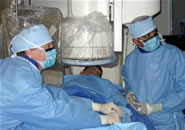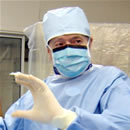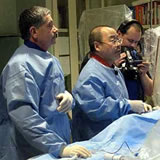
|
May 10, 2008 -- New York -- Following up on his April course, Dr. John T. Coppola, Chairman of Cardiology at St. Vincent's Hospital in Manhattan, will be presenting a two-day hands-on training course for cardiologists on the clinical, didactic and practical aspects of Transradial Access. The course will be held on June 12-13, 2008 at St. Vincent's Hospital in Greenwich Village, New York. An online brochure and registration information can be found at http://www.ptca.org/PDF/St_Vincents_Radial_Course_june08_pdf The transradial angioplasty technique, where catheters are introduced through the wrist artery, is used widely in Europe, India and Japan, but has not been utilized much in the United States, even though many of the complications seen in the femoral (leg/groin) catheter access approach are significantly lower. Part of the reason why the radial procedure is not used as much in the U.S. has to do with the training process for cardiologists. According to Dr. Kirk Garratt of the Lenox Hill Heart and Vascular Institute of New York, "Despite the benefits of transradial access, most fellowship training programs continue to train clinical and interventional cardiologists using a transfemoral technique. That perpetuates the practice."
Five years ago, Drs. Coppola and Kwan traveled to India to learn the radial technique themselves from Dr. Tejus Patel, who began India's first transradial program and has done over 20,000 transradial procedures. Attendees at the upcoming St. Vincent's course will have the chance to learn from Dr. Patel's own mentor, Dr. Shigeru Saito, Director of Cardiology and Catheterization Laboratories, Shonan Kamakura General Hospital and Sapporo Higashi Tokusyukai Hospital in Hokkaido, Japan.
To assist in educating the professional and patient population in the U.S. about the this technique, Angioplasty.Org has created the "Radial Access Center for Transradial Approach", a special section devoted to information and news about the transradial technique, for both patients and physicians. The Radial Center features interviews with leading practitioners of the radial technique, such as Drs. Jeffrey Popma, R. Lee Jobe, John Coppola, Kirk Garratt and Howard Cohen. For patients there is also a "Hospital Locator" that lists U.S. centers practicing radial angiography. As Dr. Howard Cohen, also of Lenox Hill Hospital, says of the wrist technique, "Patients really prefer it. 95% of people who've had it both ways would say 'I'm coming back to you, Dr. Cohen because I like this transradial a lot better than the other way!'" Details on registering for this course are available in this online brochure. The course is being held on Thursday and Friday, June 12-13, 2008, at:
The course receives support from Terumo Interventional Systems. |


